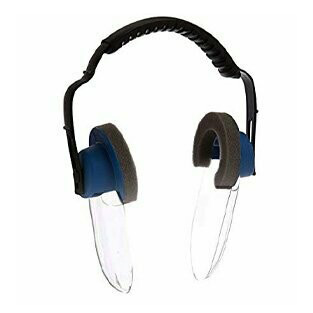
HearFones Vocalist Training System
Have you ever wished you could hear your own voice better when you sing? Then the HearFones are for you!
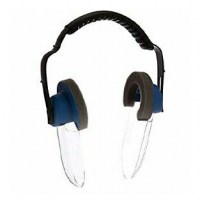
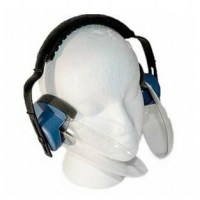
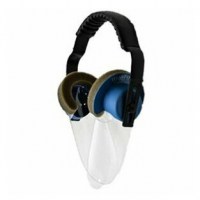
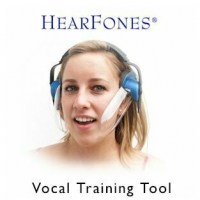
ex vat: £41.63
vat: £8.33
£49.95
Product SKU: VC-HEAR-F
Barcode: 662425041596
Description
A headphone-shaped apparatus with two curved pieces of plastic that extend in front of your face, angled toward your mouth, the principle is that HearFones reflect your your own voice directly to your ears, thus enabling you to hear your own voice better.
This revolutionary new tool allows vocalists and singers to hear very clearly the real, untainted sound of their own voice.
Ordinarily, the vocalist doesn't hear their own voice clearly, as mainly what they're listening to are the reflections of their singing in the room.
With HearFones, vocalists hear what they really sound like -- the same voice the audience hears! In addition, while using HearFones, the vocalist hears themself much more predominantly over the rest of the ensemble, thus helping to improve the quality of output.
You can practice your part right there while singing with the whole group. With simple instructions and a sincere effort to sound better, the singers in the ensemble can soon improve their performance dramatically.
All it takes is HearFones... and the desire to get better... to reach the goal of beautiful singing. The booklet "Singing Secrets" included with HearFones outlines simple steps needed to produce better individual sound.
Many singers feel that when singing in a group their own efforts are not heard out front and thus sense that any vocal inadequacy will go unnoticed. Not so. You cannot take poor quality singing, multiply it by 40 and get good singing. The chorus director cannot monitor all the voices individually, but each singer can!
The inventors of HearFones, teachers and singers themselves, recognized these problems and believed that good acoustic design could bring the benefits of this neat concept to every singer. They found that time after time every singer sang better just by putting on HearFones!
In addition, in the hands of a director, the singer can be shown the appropriate sound to sing, then, with HearFones, the singer duplicates the director's sound, often as necessary, to reproduce the instructor's example. After singing good sounds using the HearFones, the singer knows how it feels to sing this way and, in time, will be able to duplicate the sound without the "training wheels". It's that simple.
No step in the use of HearFones violates any recognized good singing practices. The beauty of it all is that it gets right to the heart of the matter... good sounding singing...right off! This is quality control in music and a great way to build confident singing.
It should be emphasized that one of the most important contributions of this tool is that HearFones focuses the singer's attention on his own voice, often for the first time.
Ensembles may use HearFones to produce better quality sound in recording sessions. Soloists will find this tool most useful in their own vocal improvement in any singing style. Speakers use HearFones to monitor their own diction, modulation and delivery. HearFones also find many uses in the Speech and Hearing Therapy fields.
Not since Guido d'Arezzo's music notation in 1030 has there been such a help for the singer.
Your HearFones can be adjusted for fit by sliding the sound guides up or down in the headbank slots. The cushions should surround your ears, with the forward sound guide tips near your mouth to provide the greatest volume. Tilting the tips down a bit will reduce the strength of feedback.
See more at:
wikipedia.org/wiki/HearFones
Research Findings:
"Effects of HearFones on speaking and singing voice quality" (Abstract)
Department of Speech Communication and Voice Research, University of Tampere, Tampere, Finland
Laukkanen AM, Mickelson NP, Laitala M, Syrj? T, Salo A, Sihvo M.
HearFones (HF) have been designed to enhance auditory feedback during phonation. This study investigated the effects of HF (1) on sound perceivable by the subject, (2) on voice quality in reading and singing, and (3) on voice production in speech and singing at the same pitch and sound level.
Test 1: Text reading was recorded with two identical microphones in the ears of a subject. One ear was covered with HF, and the other was free. Four subjects attended this test.
Tests 2 and 3: A reading sample was recorded from 13 subjects and a song from 12 subjects without and with HF on. Test 4: Six females repeated [pa:p:a] in speaking and singing modes without and with HF on same pitch and sound level. Long-term average spectra were made (Tests 1-3), and formant frequencies, fundamental frequency, and sound level were measured (Tests 2 and 3). Subglottic pressure was estimated from oral pressure in [p], and simultaneously electroglottography (EGG) was registered during voicing on [a:] (Test 4).
Voice quality in speech and singing was evaluated by three professional voice trainers (Tests 2-4). HF seemed to enhance sound perceivable at the whole range studied (0-8 kHz), with the greatest enhancement (up to ca 25 dB) being at 1-3 kHz and at 4-7 kHz. The subjects tended to decrease loudness with HF (when sound level was not being monitored). In more than half of the cases, voice quality was evaluated "less strained" and "better controlled" with HF. When pitch and loudness were constant, no clear differences were heard but closed quotient of the EGG signal was higher and the signal more skewed, suggesting a better glottal closure and/or diminished activity of the thyroarytenoid muscle.
Hearfone Stories:
We got an excited phone message: "I am lead of 1992 champion Sweet Adelines quartet, saw and heard HearFones being used by a quartet I was coaching and found them to be one of the most exciting and effective things for singers I've ever seen or heard. I coach a lot of quartets and choruses and could sell a ton of these things. I would like to become a dealer."
A choir director from Austin Texas called that she received her HearFones. "They're great; work just fine. Can I get a better price by the dozen? I'm bringing it up before the music committee." (Yes, she can get a better price by the dozen).
Choir director Sally Trice says, "I find HearFones helpful with singers' intonation, and the rest of the choir notices the difference." She continues, "They often make the singers' voices seem softer and (they) sing with better fidelity and less distortion. The choir then blends better. One of my singers especially likes to use HearFones in her vocal warm-ups."
Nancy Lacasse writes, "I want to thank you for bringing me this wonderful invention. For years I've been complaining about not hearing myself or my real voice . . . Now I can correct myself while my jaw and muscles are still in position. It's just wonderful . . . I love these HearFones."
"I work with a jazz trio in which I'm the bassist, vocalist, electronic musician. I love your product. I use it to warm up . . . and next time I record a demo for the band, I will have my HearFones on! I recorded a cassette tape of children's music with my wife and family, and I did most of the vocals. I wish I was using HearFones then. Keep up the good work.
Bill Parsons in Newfoundland says, "The HearFones are fabulous. They enable me to focus more on the quality and accuracy of my singing, as well as blocking out some other folks who do not sing quite on target."
"I am a member of Sweet Adelines International and in a new quartette. I sing bass and have found the HearFones to be invaluable in not only learning my part, but working on vocal production. AMAZING. I think, no, I know the marketability of this product is fantastic."
"I wanted to express how helpful HearFones have been to my singing. The quality of my voice has improved tremendously. I especially like to use them in my vocal warm-up exercises. I simply love this product. Keep up the good work."
"I'm using my HearFones as a singer to help with harmonization. The results have been just great. You can really hear yourself (as well as everyone else)"
"As a 20-year Sweet Adeline veteran, I still couldn't understand what our chorus coaches were trying to tell to us -- until I tried HearFones. I was finally able to hear how those subtle changes in mouth shape, tongue placement, vowel forming, etc., were manifesting themselves in my vocal production. Now I can be my own coach. They're great. I love them. Dr. Ruth Freeman, in Tennessee.
E-mail from David Rourke: "I can hear every glitch. A friend says, 'Helps intonation on every note'. HearFones help solve part problems."
E-mail response: "As a singer of many different styles, I've never found a product quite like HearFones! This unique device allows you to hear very minute fluctuations in volume and tone, thereby illustrating to the user the best possible vocal control with the least possible time and effort. HearFones has my gratitude."
Letter: "Ray, just a note to let you know how much a difference HearFones has made in helping me develop voice control and delivery. I have received many more compliments on singing since I began practicing with my HearFones on. Pat Eisenhart
Letter: "Thanks . . . THEY WORK." LaDonna Thomas, Sweet Adelines Quartette champ
Letter: "I'm using my HearFones as a singer, teacher and chorus director to help discipline the children, who habitually call out without raising their hand, to help them hear what they sound like. The results have been fantastic." Jolie Shushansky, 2nd grade teacher, RI
E-mail: "Little by little, the HearFones began to make a difference . . . everyone began to get on tune. This is the first year we have seen such a dramatic difference in the elementary children's choir. We had three boys in the 7-12 grades that couldn't carry a tune in a bucket, but they now are hearing themselves." Bill and Kathy Gwyer, Robert Shaylor Academy, missionary kid school, (in the jungle) Tamatama, Venezuela
Letter: "At Harmony college I sampled . . . HearFones. They were great. I'd like a pair for my quartet."
Letter: "After 50 years of being afraid to sing, I started vocal lessons determined to set free the singer I'd always believed was in me somewhere. After a year of practicing almost an hour a day, I gave up . . . I felt more and more lost and frustrated and it seemed the more I worked on a song, the worse it got. Two years later . . . I started again. At my first lesson, she loaned me a pair of HearFones and a whole new world opened up for me. I could actually hear what I was singing (or trying to sing!) and I could hear precisely. Turns out my earlier frustration was largely due to not being able to hear clearly what I was singing and if I couldn't hear it, I couldn't sing it. I've been practicing with borrowed HearFones and I am so excited about what I hear! . . . Each time I repeat an exercise . . . I get significantly better because I can hear what I'm singing . . . Perhaps people like me who've always believed they couldn't sing, have never been willing to listen to themselves. HearFones gives us the boost we need to hear and then sing." Pat Murphy
The following is a message on Ray's answering machine after he had been teaching in a Barbershop Harmony music education school in Ohio and had later sent a set of HearFones to Don Gray, one of the other instructors at the school. Don, a singer, arranger and coach wanted to use the HearFones in his own quartet and show them to others, including Jean Barford, an experienced coach in the Sweet Adelines
"Hello Ray, my name is LaDonna Thomas and I'm calling about your HearFones. I'm in a championship quartet and was working with Jean Barford yesterday and I got to use your little apparatus and find it the most intriguing thing I've ever worked with. I'd like to know if they're available to be purchased. I have a sale going on for you right now. If you would like to call me, my number is . . . Thank you. Look forward to hearing from you"
[Ray called her to tell her they were not yet in manufacture. However, he offered to send her a prototype set for her use and for our own market testing. Later, she completed and returned two test forms, quoted below.]
"The HearFones force me to pay total attention to what I am doing or not doing. It makes me realize that when I do sing correctly it is total accomplishment and achievement. It is good to hear that concept."
"I sing everything without the 'fones and then put them on and sing the same thing. I allow myself to be critical, and then I allow my brain to fix what is wrong without thought."
"I found that if I sing with more open and resonant sound I don't have to work so hard to do it wrong! This forces me to do things right. When I take the 'fones off I almost feel as if I can't hear. That takes some adjusting."
From Teachers/Coaches:
Q: What ways do you use HearFones with your singers?
A: "While they were working on vocals or singing with someone else."
A: "While they were working on vocals or singing with someone else."
Q: How do you evaluate HearFones as a tool in improving the vocal quality of your singers?
A: "This is the most natural way of helping the singers fix themselves . . . EXCELLENT TOOL."
A: "This is the most natural way of helping the singers fix themselves . . . EXCELLENT TOOL."
Q. How do you improve the voice part balance in your ensemble?
A: "In barbershop singing, one voice can really influence the other three. This tool really makes the whole thing happen!"
A: "In barbershop singing, one voice can really influence the other three. This tool really makes the whole thing happen!"
Q: How do HearFones impart greater vocal awareness to your singers?
A: "Singers get to hear their own voice for the first time -- it truly helps them to fix what you are asking them to fix."
A: "Singers get to hear their own voice for the first time -- it truly helps them to fix what you are asking them to fix."
Q: How do HearFones help improve the tonality of your singers?)
A: "When the singers understand what to listen for without outside noise, it is amazing how they can improve tonality by themselves."
A: "When the singers understand what to listen for without outside noise, it is amazing how they can improve tonality by themselves."
Q: How do HearFones improve the personal confidence of your singers?
A: "After the singers realize that they can do what is asked, they feel a sense of accomplishment, and that is confidence."
A: "After the singers realize that they can do what is asked, they feel a sense of accomplishment, and that is confidence."
Q: How do HearFones help your singers enjoy singing more?
A: "I have a couple of students that want their own HearFones! They enjoy singing correctly and want to get used to the sound."
A: "I have a couple of students that want their own HearFones! They enjoy singing correctly and want to get used to the sound."
Q: What techniques did you employ to achieve the same sound quality in (non-HearFones) performance that you heard with singers using HearFones?
A: "I have them sing with them on, then sing with one side up and the other down, then sing one phrase with them on and the next without, etc."
A: "I have them sing with them on, then sing with one side up and the other down, then sing one phrase with them on and the next without, etc."
Q: How easily do your singers transfer the knowledge of their true sound (using HearFones) to their subsequent performance without?
A: "Most were able to continue at about a quarter of the time within the first 2 weeks. After a month, they could go 3/4 of the time."
A: "Most were able to continue at about a quarter of the time within the first 2 weeks. After a month, they could go 3/4 of the time."
Q: Have your singers used HearFones in public performance?
A: "No, but would like to."
A: "No, but would like to."
Q: What means did you use to help singers producing too little volume sing up to the level of the ensemble?
A: "The singers needs to trust that they will fix the problem and quit listening."
A: "The singers needs to trust that they will fix the problem and quit listening."
